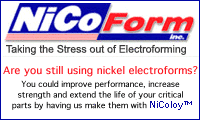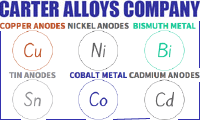
-----
Boric acid control and what it does for nickel plating?
So, what happens to all the Boron from the boric acid as it is depleted in plating baths such as sulfamate nickel and bright nickel? Greg.
Greg Watkins1995
A. Well, most boric acid in Nickel plating gets lost through dragout and ends up in the wastewater as … you guessed it … still boric acid. Trace amounts of Boron, though, where found in various Ni electrodeposits, so some of it gets into the metal.

![]()
"PlaterB" Berl Stein
NiCoForm, Inc.
![]()
Rochester, New York

Q. I have read that putting boric acid in a Napped polypropylene bag works well.
How come you don't over saturate it with this method? Am I right assuming it only takes a certain amount as per the temperature you are using? I am at 110 f. I am using a nickel sulfamate bath.
I plate on plastics, I have removed a .004" film off of the plastic and the nickel is a little brittle, if you fold it in half it will break. I have read this is due to low boric acid.
If I heat the sample red hot and let it cool it is very ductile, what's the reason for this. I use all the proper methods and mixtures. Does this sound right?
hobby - La, California
2005
A. The saturation point for the boric acid content in the nickel solution increases with the temperature. Old time platers found that at operating temperature the saturation point was near enough to the operating requirement to run at saturation.
The function of the boric acid in the bath is to increase conductivity (lessen high current density burning) and act as a buffer (keep the pH from fluctuating too rapidly). If your concern is with ductility you should look at how much metal you are depositing
(assuming you are not confusing ductility with other properties).
I know, the above is oversimplified, but I was trying to be non technical.
process supplier - Great Neck, New York
A. Boric acid is added to a plating bath to act as a pH buffer. If you do not have a buffer in the electrolyte, it will quickly go out of pH range and this will cause inefficient and poor plating, often with nickel oxides being deposited. The usual range for a nickel electrolyte is 30-40g/l, although having it higher does not usually cause problems. I know one electroformer who used 120g/l in a sulphamate bath! Boric acid is relatively insoluble in terms of common electroplating compounds and has a nasty habit of coming out of solution; when this happens it can be difficult to get back into solution, but it always goes in the end.
You do not give any indication of your plating conditions, so no-one can tell you what is wrong - we can only guess. However, nickel sulphamate is usually quite ductile if plated correctly, so if you tell us what you are doing, perhaps we can answer it. It is, however, quite possible that low boric acid can be your problem.

Trevor Crichton
R&D practical scientist
Chesham, Bucks, UK
A. Ok here it goes, my bath is 2 gallons, here's the mixture,
barrett SNR-24 3.18l
additive A 22.7 g
Snap am 23 ml
Boric 227 g
Distilled water 4L
temp 115 f
ph 3.8- 4.2
I plate on fiberglass and peel the glass out to have the nickel shell left over. The plating process works well and the PH remains stable through out the 8 hour plate. I am plating at around 24 amps a square foot.I have done the boric acid test, its around 5 oz per gallon, I did add a little to raise it. my S nickel is held in Titanium grade 2 mesh. I used to use nickel N and was told nickel S was better so I switched to Belmont's Metals S nickel. I got good results with the N nickel it was malleable before and after heating. I use the proper bags from Baker bags. The S nickel is brittle until I anneal the parts. Why is the S nickel more brittle? What can be done to make this S nickel softer, its a brand new bath and everything has been leached properly. Also, my s nickel has a black sort of sooty look to it, is this normal? I had this brittle problem after the first test sample plate of the new bath, there is no chance that I had any organic or metal contaminants in the bath. I have read that other chemicals are needed with N nickel, I never used them and it seemed to work well. Can some one please help me get this solved.
Hobby - La, California
I am not acquainted with the Barrett SNR solution, so cannot sensibly comment on its make-up. However, I am very interested in your comments about the nickel anodes. You say that N nickel is OK, but S nickel gives a black sooty look. This is most strange;- S nickel has sulfur added to assist in its dissolution by imparting depolarision onto the nickel and (in theory) doesn't need chloride in the bath to assist this. However, I presume you used this bath composition with your N nickel and got a good result; again, N nickel does need chloride in the bath to assist in dissolution and one of the characteristics of poor anode dissolution is to get a black smut over the pellets/rounds/squares. Since N nickel isn't depolarised, it is more difficult to dissolve and can passivate, resulting in blackening of the surface; this can be overcome with the addition of chloride to the electrolyte. Have you got your S and N nickel mixed up? I am therefore a bit concerned that a chloride-free electrolyte working with N nickel gives a good result (which it shouldn't!), whilst a bath that doesn't have chloride in it and uses S nickel gives a bum result (again which it shouldn't!). I am also not acquainted with "Additive A" or "Snap am", but I presume these are proprietary additives provided by your supplier and suitable for Barrett's nickel. Your operating conditions are perfectly OK, so that only leaves the fibreglass....Is something leaching out of the fibreglass? - I suspect not as the system appears to work adequately....You do not, however, mention the anode:cathode area ratio; I presume that since you are clearly a competent electroplater, you have got this right.
When you do your nickel tests do you make the coupon in the plating tank or use a sample of the solution and put it in a beaker or something? I suggest you test your electrolyte outside the tank (i.e., in a beaker) with known quality nickel anodes and check the ductility from these coupons. Hope this helps.

Trevor Crichton
R&D practical scientist
Chesham, Bucks, UK
I never had the black look with the N nickel, they remained grey and metal looking the entire time. This only happens with the s nickel. My N nickel are a random bunch or spherical balls ranging from 3mm to around 20 mm at the largest, my S nickel are around 25mm diameter, 5 millimeter tall and have a sort of flower look to them around the outer diameter. I have roughly 1 square foot of anode area in the bath which I use for parts that have 30 square inches of area to 144 square inches. This is roughly 6 pounds of nickel total, should I have less area for the smaller parts? I make the test sample in the same bath. Snap Am is a anti pit agent, and additive A is a chloride bearing salt. The fiberglass is post cured to 160f to prevent it from deforming and curing properly. My first sample was fully silver painted and plated both sides I don't think anything would have leached out of it.
Any other ideas?
Hobby - La, California
adv.: Supplier of Copper Anodes, Nickel Anodes, Bismuth Metal, & Other Metal Products for Industry & The Arts

Q, A, or Comment on THIS thread -or- Start a NEW Thread